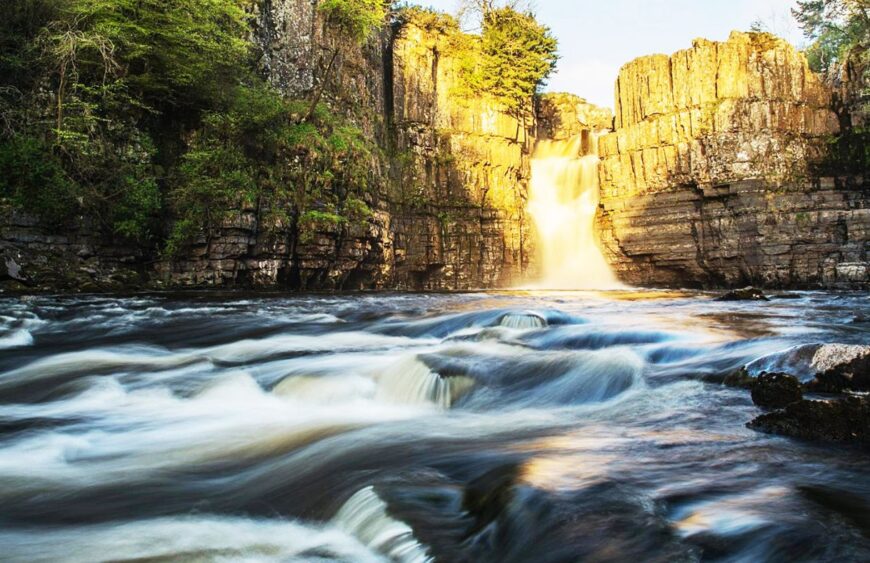My interest in the Alfred Wainwright inspired Pennine Journey path came about as a result of a chance meeting on the St Cuthbert’s Way in 2012.
I knew all about Alfred Wainwright and his iconic Lake District hiking guides and nearly 40 years ago I walked the Coast-to-Coast path, but I knew nothing about his 1938 walk as the clouds of war were gathering and he sought to quell his fears of what was to come by striding out into the Pennines.
It was while my son Oliver and I were walking the St Cuthbert’s Way that we met David and Heather Pitt, long time Wainwright enthusiasts, members of the Wainwright Society and founders of the 247-mile Pennine Journey path. Some years later, David and Heather and their band of Pennine Journey Supporters Club committee members had little trouble in persuading me to help promote this wonderful if not terribly well-known long-distance path that starts in Settle, runs up the east side of the Pennines, along Hadrian’s Wall and then back down the west side of the Pennines to Settle.
The path should go down in the annals of British hiking history because of its links to Wainwright. He wrote an account of his journey in 1939 but this was not published until 1986 as “A Pennine Journey: The Story of a Long Walk in 1938”. To recognise its significance one has to bear in mind that Wainwright’s walk pre-dates the creation of the Pennine Way by some 27 years.
The story of the walk then jumps forward to 1998 when David and Heather Pitt completed their own version of Wainwright’s Pennine Journey leading to the publication of A Pennine Journey guidebook in 2010, and recognition by the Ordnance Survey in marking the route on its OS 1:25,000 Explorer maps.
While sections of the walk are shared with the Pennine Way, it is less of a linear high moors marathon hike following the backbone of the Pennines and more about meandering its way through attractive villages and towns in Yorkshire, County Durham and Cumbria.
Both paths have their merits but perhaps it was telling that the great man himself said in reference to the Pennine Way: “You won’t come across me anywhere along the Pennine Way, I’ve had enough of it.” He had, of course, already walked it and detailed his experiences in his 1968 Pennine Way Companion.
My initiation into the route came this past October (2022) when, with friends, I took on the first 80 miles from Settle to Westgate-in-Weardale, and what a journey it is. We were fortunate that for the most part the weather was kind to us throughout our seven days on the trail.

We used Brigantes walking holidays and baggage transfer company to arrange our itinerary and were extremely satisfied with their service. As it happens, on day two we passed by their office in Halton Gill and stopped in for a welcome cup of tea and chat with owner Annette Hirst

It wasn’t our intention to set a blistering pace and our daily average was circa.11.5 miles giving us time to take in the magnificent scenery and pausing from time to time to discover some of the history of the countryside we were passing through.
Having never ascended any of the Yorkshire Three Peaks a minor diversion off the main Pennine Journey route allowed us to tick off Pen-Y-Ghent which was the toughest climb in our seven days of walking but hardly taxing for the seasoned walker – why should you do it? Because it’s there, but then you miss out on that other spectacular local landmark the collapsed cavern of Hull Pot.


The beauty of the east side of the Pennine Journey is that while it includes plenty of stretches of high moorland – indeed part of the route is shared with the Pennine Way – there is plenty of contrast, with the dales it passes through including Swaledale, Wensleydale, Teesdale, Ribblesdale, Weardale and Wharfdale. The chocolate box villages in many of these Yorkshire Dales including Buckden, Bainbridge, Askrigg, Gunnerside and Keld provide welcome stopping off points for refreshments and accommodation, and help to support the local economy.
And there is plenty of history on the route to add pleasure to each day’s hiking. On passing through the hamlet of Stalling Busk near Bainbridge we came across a blue plaque on the side of a cottage boldly announcing THE STALLING BUSK CONFERENCE, being the spot where The Ramblers met in 1996 to draft what became the Countryside and Rights of Way Act 2000 allowing us hikers the right to roam over 865,000 hectares of land. We have a lot to thank them for really.

Shortly after we came across an information board besides the natural lake of Semer Water where JMW Turner stopped at that exact spot in July 1816 to sketch the lake being one of 400 hundred sketches he made on his tour of North Riding.
For industrial archaeology there is no better location than alongside the River Tees on the path leaving Middleton-in-Teesdale. As well as coming across the spectacular waterfalls of Low and High Force there is the Wynch Bridge, a chain suspension bridge across the river Tees close to where in 1741 it is thought that the first chain bridge in England was built by public subscription to allow lead miners from Holwick to reach the Middleton mines.


Our first seven days on the Pennine Journey path were extremely enjoyable with no part proving too taxing. OK, there were a small number of parts of the route where it was boggy requiring expertise in tussock hopping and one small section on Swinhope Moor where there is no discernible path. However, our OS App was able to guide us to the lane down into Westgate-in-Weardale where our journey finished with, conveniently, a bus service to Bishop Auckland and then back south on the train via Darlington.

We are very much looking forward to continuing the Pennine Journey in 2023 which will include a section along Hadrian’s Wall and then back south on the west side of the Pennines. The route with its Wainwright history and variety of terrain is a must for those into long distance walking.

Words By Richard Aylwin
Richard is the volunteer PR officer for the Pennine Journey Supporters Club, PR and Communications professional by day, and enthuasiastic long distance walker, tackling the Pennine Journey in parts during weekends and holidays.





Colin Burchett
22 February 2023 at 10:55We are Fell View B&B in Slaggyford on the Pennine Way. Wainwright drew a beautiful picture of our house (as we are next door to the old Post Office he visited ) which is in the illustrated version of his book.